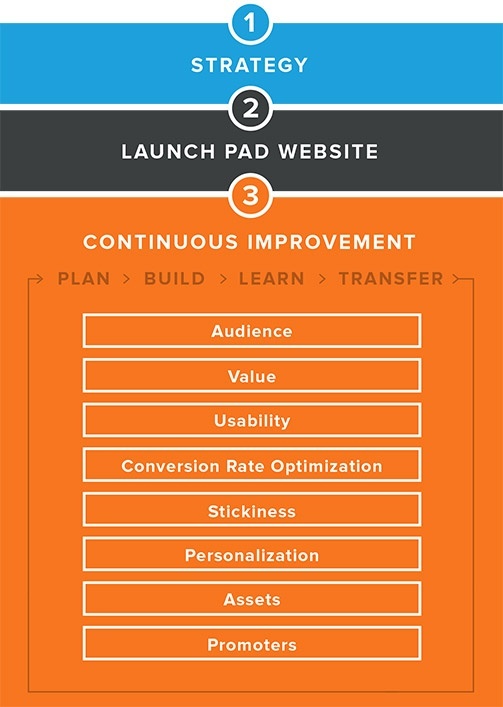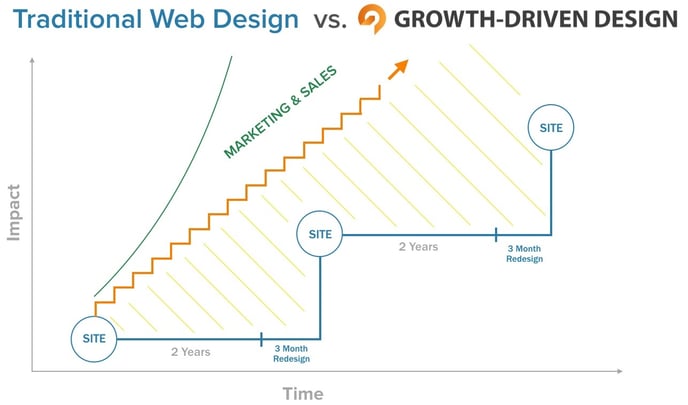
GDD vs. Classic Website Project: Which Approach Is Right for Me?
November 19, 2019
By Aaron Riddle
In the world of website redesigns, a new website can be a daunting task.
With a high price tag and a large chunk of your marketing budget, it can certainly be a make-or-break scenario for most organizations.
Because of the standard cost and time investment, the need for a different approach has risen — and been met by growth-driven design. Although many organizations are looking at new alternative approaches to the traditional website design process, it might not be right for you.
So let’s do a quick deep dive into both traditional website design and GDD to find out which one can help with your organization’s goals and objectives.
Traditional Website Design
If you’ve been in the marketing or website development space for quite some time, you’ve probably been through a few website redesigns and have followed the traditional website design process.
This process has been used by organizations for years and does have some benefits to certain organizations, but there can be some difficulties that come with this type of approach.
Process
Since the inception of web design, the shape and format have largely stayed the same. The below outline might seem very familiar.
- Get a team together.
- Work hard to discuss with management team and stakeholders to allocate a large chunk of budget to work on the website.
- Plan together, giving ample time for each person to vent their frustrations and/or ideas.
- Put three to six months into the website launch process.
- And voila! A brand-new website to please stakeholders and management for two to three years until we repeat the process again.
Strengths of Traditional Website Design
In terms of traditional website design, it’s a tried-and-true process and approach that web developers and marketers have been using for years, with a particular upside to certain organizations.
- It’s Well-Known by Everyone – When asking for more budget or getting management approval, this is one approach that your management team and stakeholders will understand when they think of website design.
- A One-Time Resource Allocation – In terms of resource allocation from both internal and external vendors and employees, they are self-contained into this one project and not needed on an ongoing basis. This may be helpful for organizations that don’t have internal resources to staff an ongoing project month over month.
Weaknesses to Traditional Website Design
While it’s a tried-and-true approach to website design, that doesn’t mean it doesn’t have faults of its own along the way.
- Large Up-Front Costs – A brand-new website out of the box can cost $25,000 to $80,000. This is money that most small to medium-sized businesses either don’t have lying around to spend or is something that can take over most or all of your marketing budget for the year.
- No Guarantee of Performance Metrics at Time of Launch – In term’s of launching a traditional website, the focus can be more on getting the look and feel right to suffice management and stakeholders for a couple of years.
- Direction Can Change/Influence Timelines – Even with the utmost planning and detail prior to your latest project, there can always be management or outside feedback that can slam on the brakes and have you extending your dates, scope, and budget.
Growth Driven Design (GDD)
While the term growth-driven design is relatively new, the concept isn’t. This is a process that’s been running through the agile Web development phases for quite some time. Instead of working through the traditional cycle path of website design, the goal is to get online fast and begin to test and iterate from there.
Process
The process of GDD revolves around building and optimizing your website focused on metrics, buyer personas, and data. Instead of building everything at once and leaving it alone, GDD prioritizes an initial “launchpad” website that can go live quickly. Once this has occurred, monthly iterations are conducted based on user experience and website data, as well as additional priorities to improve and continue to build out the website.
This can be broken down into three key phases of implementation:
- Strategy - One of the first things that GDD provides to the website design process is a clear focus on strategy. This includes relating your website decisions to your goals, personas, buyer’s journey mapping, and internal assumptions.
- Launchpad Website - Once you have the strategy in a solid place, it’s time to put together a launchpad website. This is a much smaller version of your website with only the key areas of your website. In GDD, it’s not about quantity; it’s all about QUALITY and launching as quickly as possible, while building only the core, value-driving elements. During these conversations, you can continue to add to the wish list certain items that won’t make the launchpad website. This then leads to prioritization of your website and tailoring your future iterations to those high-priority/quick-win items once the new website is launched.
- Continuous Improvement - Your launchpad website is up and running; now comes the huge benefit to how GDD can perform for your business. From here, you have a roadmap for your organization for future iterations to your website to have it performing at its best.
Strengths
GDD is all about getting up and live quickly to begin testing and making iterative decisions based on your goals. It can also save you money in the short term of things as well.
- Much Lower Up-Front Costs – The initial investment is much lower and can be spread out over the course of the launchpad and monthly iterations. This type of model also helps with your long-term budget strategy, as you can allocate more or less funding as the project goes on.
- Time It Takes to Go Live Is Dramatically Reduced – By focusing your efforts on the core, value-driving elements for the launchpad website, you are able to go live much faster and prioritize your monthly iterations to add later.
- Metrics Are Measured Continuously for Additional Improvements – Risk is mitigated substantially as monthly iterations can help identify gaps quickly and begin discussions and analytics to improvement.
Weaknesses
With GDD coming into the conversation, there’s still a bit of that “new car smell” to it that’s causing some organizations to hold off on it until it’s a proven success for others.
- GDD Is “Relatively” New – While GDD takes many of its concepts and ideas from the agile Web methodology, the term is still gaining traction in the community. This could hold back organizations that would instead go with something more comfortable for themselves.
- Has an Ongoing Element – With GDD, there’s an ongoing iterative phase, potentially making organizations that would prefer a hard deadline to certain projects shy away from it.
While each process has its own strengths and weaknesses in terms of cost, time, risk, and analysis, there’s a clear winner in terms of concept and alignment to business objectives and your inbound strategy:
- GDD gives you the flexibility and opportunities to begin on a monthly, iterative path to success, similar to your inbound marketing initiatives.
- Traditional website design is a one-and-done effort that will get you out of the weeds in the short term but could have a long-term impact to your organization’s goals and objectives.

About the author
Aaron Riddle was formerly a Digital Project Manager at SmartBug Media. He has more than 9 years of marketing and project management experience helping organizations succeed in their digital marketing goals and objectives ranging from not for profits to large technology-based groups and businesses. Read more articles by Aaron Riddle.










